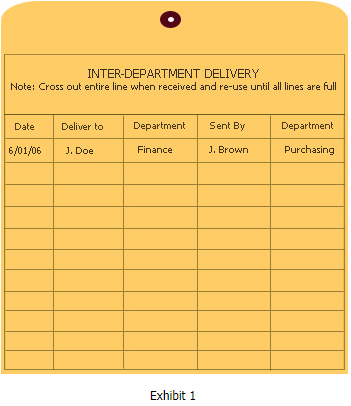Internal Mail
This mail consists of enveloped correspondence for delivery to the addressee. To provide proper delivery, internal mail requires a full name and provider code of the agency.
PROVIDER CODES
The term provider code is used to identify a location internally and for internal billing of services. Each department or field office has been assigned a four-digit provider code. If you don't use a provider code on internal mail, it can't be delivered correctly. For example: every section has a Personnel Office. A provider code is critical for the correct delivery.
See State Agency Mailers Info on this website for the most frequently used provider codes. Use provider codes as part of your return address for internal and external mail. It will expedite your replies. We recommend using your provider code on business cards and stationery.
Hand Mail Envelopes-RED
The use of these envelopes will expedite your internal mail delivery. Simply address it, indicating the full name and provider code of recipient's agency. These envelopes should be banded and not mixed with regular outgoing mail.
Plain Envelopes
The one-line format is preferred when addressing inter-agency mail on white envelopes. However, the two-line format may be used if necessary. Avoid three or more lines because such mail can be mistaken for U.S. Mail pieces. Each internal envelope must have either HANDMAIL stamped or handwritten in the upper right corner of the envelope. These envelopes should be banded and not mixed with regular outgoing mail.
Inter-Office Envelopes (see Exhibit 1 below)
These are envelopes used repeatedly for internal mailings. When using Inter-Office envelopes, make sure all previous markings have been marked out to ensure proper handling and direction to the intended recipient.

Internal Parcels
The addressing of parcels and packages for internal distribution is the same. Use the full name and exact provider code.
Change of Address
A change of your internal location must be acted upon promptly! As soon as you learn of your new location, call the Division of Facilities Management Administrative Assistant (see Contact List) with the new address, telephone number, effective date and a contact person.
ENCLOSURES
Non-machinable Items
A letter-sized or flat-sized piece is non-machinable if it has one or more of the following characteristics and is subject to an additional surcharge:
- a. Has an aspect ratio (length divided by height) of less than 1.3 or more than 2.5.
- b. Is polybagged, polywrapped, enclosed in any plastic material, or has an exterior surface made of a material that is not paper.
- c. Has clasps, strings, buttons, or similar closure devices.
- d. Contains items such as pens, pencils, keys, or coins that cause the thickness of the mailpiece to be uneven; or loose keys or coins or similar objects not affixed to the contents within the mailpiece. Loose items may cause a letter to be nonmailable when mailed in paper envelopes.
- e. Is too rigid (does not bend easily when subjected to a transport belt tension of 40 pounds around an 11-inch diameter turn).
- f. For pieces more than 4-1/4 inches high or 6 inches long, the thickness is less than 0.009 inch.
- g. Has a delivery address parallel to the shorter dimension of the mailpiece.
- h. Is a folded self-mailer that is not prepared appropriately.
Envelopes
Envelopes should be of the right size and strength to accommodate the enclosures.
- a.The size should properly accommodate the insert(s). Excessively large envelopes will not keep the inserts firm. The inserts in such envelopes slide, creating an imbalance of the envelope, increasing the risk of ripping and loss of contents. A snug fit keeps the enclosure firm in the envelope.
- b. Conversely, when an envelope is overstuffed it can burst at the seams. The result can be a total loss of the mailing.
- c.The strength of the envelope should withstand the weight of its contents. If there is stress at the seams or sharp edges, the envelope is overloaded and can burst, increasing the chance of contents being lost. Use a larger envelope.